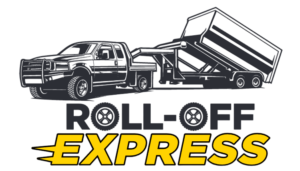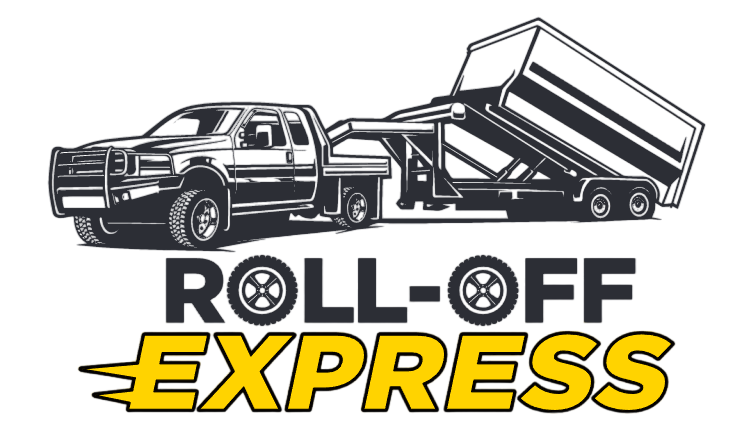

Cleaning dumpsters isn’t just messy; it’s challenging without the right gear. To clean efficiently and thoroughly, you’ll need these essential tools and materials:
Hand Protection Gloves:
Crucial for safeguarding your hands from grime, bacteria, and potential sharp objects.
High-Pressure Surface Cleaner:
Great for eliminating stubborn dirt and debris from the dumpster.
Grease-Cutting Soap:
Tailored for breaking down grease and oil, perfect for food-related industry dumpsters.
Durable Garbage Bags:
Important for discarding any remaining waste found while cleaning.
Pressure Washer:
A must-have for heavy-duty cleaning, powerful enough to remove tough stains and dirt.
Chemical Cleaners:
Essential for in-depth cleaning to combat serious grime and bacteria.
Targeted Cleaning Solutions:
For commercial dumpsters, especially those in food waste management, use solutions formulated to handle grease and prevent bacterial growth.
Equipped with these tools, you’re ready to handle any dumpster cleaning task, ensuring cleanliness and hygiene.
For safety tips and strategies using the right cleaning equipment, don’t miss reading ‘3 Top Types of Safety Gear & Strategies for Cleaning Pros.’
Dumpster cleaning, especially in commercial areas, demands a meticulous and organized method to ensure safety and hygiene. Here’s a detailed guide for effective dumpster sanitation:
Safety Gear and Preparation:
Start by donning protective equipment like gloves, goggles, and a mask to protect against bacteria and debris.
Waste Removal:
First, clear the vicinity of the dumpster. This involves emptying all trash bins and roll-off dumpsters. Watch out for hazardous materials or sharp objects.
Sweeping and Preliminary Rinsing:
Sweep the area to eliminate loose dirt. Pre-rinse the dumpster’s inside and outside with a hose, which aids in a more effective cleaning.
Application of Cleaning Agents:
Mix bleach or a commercial cleaner. Generously apply it to the dumpster’s interior and the surrounding pad to dissolve grease, grime, and bacteria.
Scrubbing:
Use a long-handled brush for stubborn stains, agitating surfaces to remove tough grime.
Pressure Washing:
Employ a pressure washer to deeply cleanse the dumpster, focusing on greasy and stained spots. The high pressure ensures thorough dirt removal.
Rinsing and Sanitizing:
Post-pressure washing, rinse with clean water. Then, use a disinfectant spray to kill any remaining bacteria or viruses, ensuring a sanitary environment.
Drying and Odor Control:
Let the dumpster and area dry completely. Optionally, use a deodorizer for any residual odors, keeping the environment fresh.
Disposing of Waste and Cleanup:
Dispose of waste and cleaning residues responsibly, adhering to local laws. Clean and store all used tools and equipment.
Routine Maintenance:
Implement a regular cleaning schedule for the dumpster to avoid waste and bacteria accumulation, maintaining a consistently clean and hygienic area.
Adhering to these steps ensures effective dumpster upkeep, creating a safe and hygienic space for everyone.
For additional insights on dumpster cleaning, refer to the resource ‘How To Clean A Dumpster.’
For dumpster hygiene and longevity, regular upkeep is crucial. Focus on cleaning these areas:
Interior of the Dumpster:
Constant waste exposure makes this zone prone to bacterial growth and bad smells. Regular interior cleaning is vital for health and safety, ensuring the dumpster stays hygienic.
Exterior of the Dumpster:
Over time, the exterior can gather dirt and debris. Cleaning it preserves its appearance and condition.
Dumpster Pad:
The area around, particularly near trash bins and roll-off dumpsters, needs frequent cleaning to avoid grease accumulation, which can be hazardous, and to protect the pad’s integrity.
Surrounding Area:
It’s equally important to clean around the dumpster. Sweep for debris and wash any spills or stains to deter pests and maintain cleanliness.
Regularly cleaning these areas prevents health risks, keeps the dumpster functional, and ensures a clean, safe environment for all.
Effectively cleaning a dumpster pad can be accomplished through several methods, tailored to the specific level of dirt and type of stains. Here’s an overview of various approaches:
Description:
This technique uses milder water temperatures and less harsh chemicals, making it perfect for routine maintenance and surfaces vulnerable to high pressure.
Process:
Start by applying a gentle cleaning solution to loosen dirt and grime. Follow with a low-pressure rinse, ensuring the surface remains undamaged.
Benefits:
This method is safer for delicate surfaces, minimizing the risk of harm to the dumpster or pad. Additionally, its environmental friendliness comes from the use of mild chemicals.
Description:
High-pressure power washing, often with heated water, is employed to eliminate tough stains and ingrained dirt. It’s a more intensive approach, suitable for heavily soiled surfaces.
Process:
Utilize a high-pressure washer, sometimes with hot water, to break down and remove stubborn stains, grease, and dirt accumulation. The pressure level can be adjusted based on stain severity and surface resilience.
Benefits:
High-pressure washing excels in deep cleaning, particularly effective for areas with significant grease and grime. Hot water further boosts its cleaning efficiency, making it a go-to choice for commercial and industrial dumpster pads.
Description:
In certain scenarios, employing a blend of both soft washing and high-pressure washing can be advantageous.
Process:
Begin with a soft wash to mildly loosen surface dirt, then proceed with focused high-pressure washing on more stubborn stains. This strategy ensures a thorough clean without inflicting damage.
Benefits:
This dual-method approach allows for an effective clean while reducing the risk of harm to the dumpster and its surroundings. It is particularly beneficial for dumpsters featuring a combination of delicate and durable surfaces.
The choice of cleaning method should be based on the dumpster’s condition, the nature of the waste it typically contains, and the materials of the dumpster and pad. Regular evaluation and cleaning with these techniques can greatly extend the lifespan of a dumpster and ensure a sanitary environment.
To complement the cleaning techniques, there are several proactive measures you can take to keep your dumpster clean over time.
Quality:
Opt for high-quality, heavy-duty trash bags. These are less likely to tear or leak, effectively containing waste.
Suitability for Waste Type:
Particularly for businesses dealing with food waste, it’s vital to choose bags that can handle organic materials without deteriorating or leaking.
Size and Fit:
Make sure the bags are appropriately sized for your dumpster. Oversized bags can drag and tear, while undersized ones may not securely contain all the waste.
Regular Maintenance:
Regularly check to make sure the dumpster area, especially the concrete pad, stays dry. Tackle any standing water or leaks without delay.
Drainage:
Ensure there is good drainage around the dumpster to avoid water buildup.
Quick Response to Spills:
Act fast on any spills within the dumpster. Use absorbent materials to mop up liquids, then clean thoroughly to avert odors and bacterial proliferation.
Secure Lids:
Keep the dumpster lids shut and tightly secured. This deters animals from accessing the trash and helps to lessen odors that might attract them.
Fencing or Enclosures:
In areas prone to animal interference, consider setting up fences or enclosures around dumpsters.
Regular Inspection and Repair:
Frequently examine the dumpster for damage or openings that could invite animals. Promptly mend any damages to lids or sides of the dumpster.
Implementing these steps greatly aids in maintaining dumpster cleanliness and hygiene, reducing the need for frequent and intense deep cleaning, and creating a more pleasant environment for everyone involved.
In dumpster pad cleaning, pressure washing is a standout method, particularly for tough cleaning tasks. Here’s why it’s often the top choice:
Deep Cleaning Capability:
Pressure washing effectively penetrates and removes hard stains, grease, and even rust (with a rust remover). The high-pressure water stream efficiently breaks down and washes away ingrained dirt and grime.
Expertise and Precision:
Professional pressure washing companies bring years of experience, knowing exactly how to balance cleaning agents and water temperature. This expertise ensures effective, surface-safe cleaning.
Efficiency:
Pressure washing quickly cleans large areas, perfect for commercial dumpster pads. This speed is a time-saver compared to manual scrubbing or weaker cleaning methods.
Customized Solutions:
Pressure washing experts can adapt their techniques for different stains and surfaces, like adjusting pressure, water temperature, or selecting specific cleaners for optimal results.
Preventive Care:
Regular pressure washing prevents grime and rust accumulation, prolonging the dumpster pad’s lifespan. This maintenance is key to keeping the area in top condition.
Convenience for Business Owners:
Outsourcing pressure washing means businesses spend less time on maintenance, keeping their dumpster area clean and safe without straying from core operations.
Overall, pressure washing is effective, efficient, and valuable for maintaining a hygienic dumpster area, a popular choice among business owners.
For detailed insights on pressure washing your dumpster pad, refer to ‘Dumpster Pad Power Washing & Cleaning – What to Know’.
For commercial properties, particularly high-traffic areas like construction sites and parking lots, regular upkeep of dumpster zones is crucial. Maintaining a clean dumpster pad not only boosts customer satisfaction but also prevents the area from turning into a potential hazard.
Proper Disposal Practices:
It’s essential to correctly dispose of waste, particularly hazardous types. This means choosing suitable dumpster rentals and making sure trash bags are properly sealed and placed in designated areas.
Expert Cleaning Services for Commercial Properties:
Employing professional cleaning services, such as commercial power washing, is a key strategy for maintaining the area. These experts can effectively deal with grease spills and tough stains, achieving optimal results efficiently.
Ensuring the safety and hygiene of a dumpster pad is crucial, especially for property managers overseeing commercial properties. Regular cleaning of the dumpster pad is essential, not just advisable, to prevent it from becoming a hotspot for bacteria and other health hazards.
Routine Cleaning Regularly:
Regular and thorough cleaning of the entire dumpster pad and its interior is vital. This includes promptly dealing with grease spills and using suitable cleaning agents.
Addressing Potential Hazards:
Being vigilant about potential dangers like hazardous waste or slippery spots from grease is important. Consistent inspection and cleaning can help reduce these risks.
Professional Dumpster Pad Cleaning Services:
Engaging professional cleaning services can greatly enhance the longevity of your dumpster pad. These services provide customized cleaning approaches, ensuring a sanitary environment.
By adhering to these practices and focusing on regular maintenance, commercial property managers can maintain a clean, efficient, and safe dumpster area for their properties now and in the future.
For more tips and insights on cleaning dumpster pads, check out the video ‘How To Power Wash a Restaurant Dumpster Pad From Beginning to End’.
Essential Tools for Effective Cleaning:
Key items like protective gloves, high-pressure surface cleaners, degreasing soap, sturdy trash bags, pressure washers, chemical cleaning agents, and specialized cleaning solutions are crucial for efficient dumpster cleaning.
Step-by-Step Cleaning Guide:
Begin with safety measures and debris removal. Proceed with sweeping, pre-rinsing, applying cleaning solution, scrubbing, pressure washing, rinsing and disinfecting, then drying and deodorizing. Finish with waste disposal and regular upkeep for the best results.
Regular Maintenance Areas:
Focus on cleaning both the interior and exterior of the dumpster, the whole pad area, and nearby spaces to prevent health hazards, odors, and to preserve functionality.
Cleaning Methods:
Select soft washing for regular maintenance and sensitive surfaces, or high-pressure power washing for more intense stain and grease removal. A hybrid approach can be adapted to various situations.
Proactive Steps for Cleanliness:
Use appropriate trash bags, ensure the dumpster remains dry, and secure it against animals. These practices help maintain a clean and appealing environment.
Advantages of Pressure Washing:
Notable for its deep cleaning abilities, time efficiency, and professional expertise, pressure washing is particularly beneficial for commercial dumpster pads, providing preventive maintenance advantages.
This all-encompassing guide includes everything from necessary cleaning tools to the most effective methods and maintenance strategies. Adhering to these guidelines guarantees a clean, safe, and sanitary dumpster area.
To effectively clean dumpsters, use a multi-step approach. Start by removing debris and pre-rinsing. Apply a degreasing solution, particularly for dumpsters handling food waste. Employ a pressure washer for thorough cleaning, then rinse, disinfect, and deodorize. For challenging stains, combining soft washing with high-pressure washing can be very effective.
Yes, sanitizing a dumpster is essential. Regular sanitization is key to eradicating bacteria and minimizing health hazards. After cleaning, it’s important to apply a disinfectant to both the interior and exterior of the dumpster for comprehensive sanitation.
Indeed, cleaning dumpster pads is necessary. Regularly cleaning the pad prevents grease accumulation, removes odors, and decreases slip-and-fall risks. This also prolongs the pad’s lifespan and upholds the cleanliness of the surrounding area.
The frequency of cleaning dumpsters depends on their usage. For commercial sites and areas with high traffic, monthly cleaning is recommended. In situations of intense use or in warmer climates, more frequent cleaning may be needed to avert odors and deter pests.
To prevent dumpsters from developing odors, maintain regular cleaning and sanitization routines. Use odor-neutralizing agents post-cleaning. Ensure waste is properly disposed of in sealed bags and avoid overfilling the dumpster. Keeping the surrounding area clean also plays a crucial role in odor control.

Roll-Off Express | LETS TALK TRASH | Dumpster Rentals